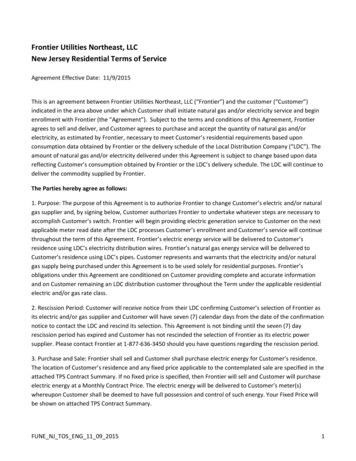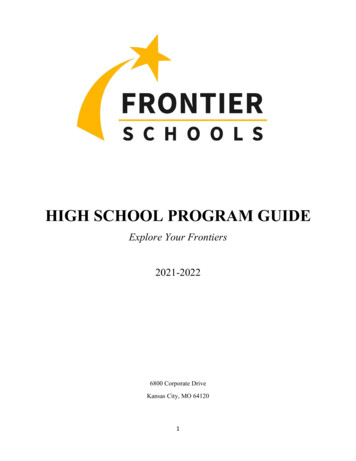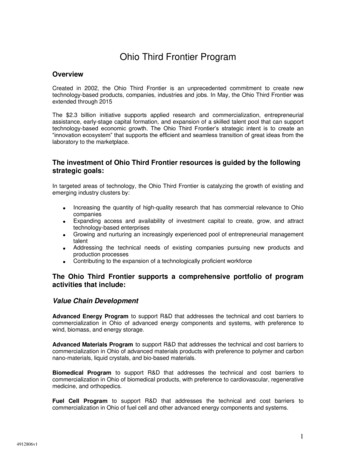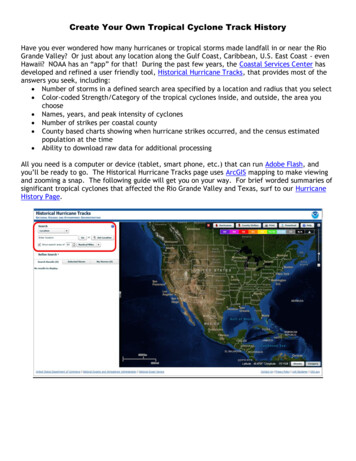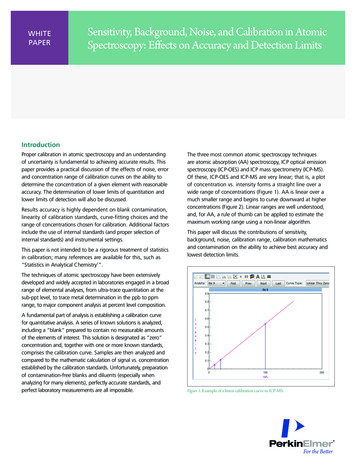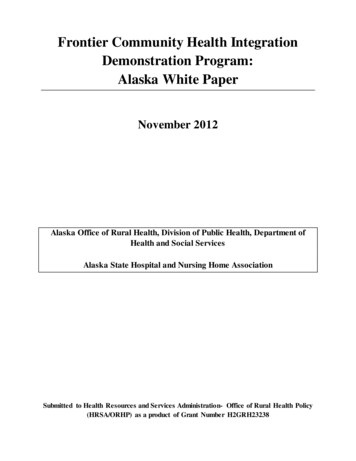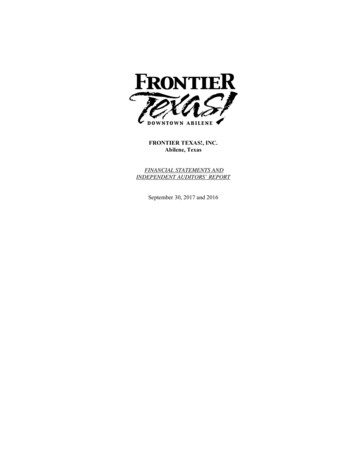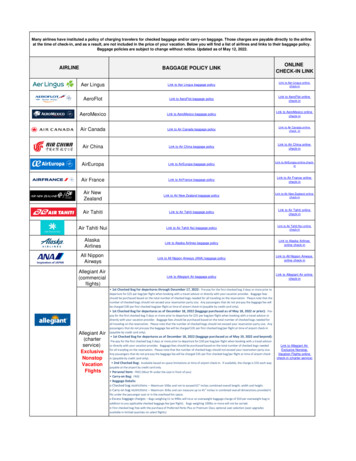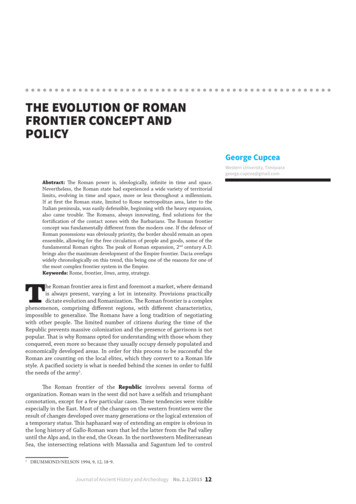
Transcription
USQCD intensity-frontier program:PerspectiveRuth Van de Water for the SPC2013 USQCD All Hands’Meeting
Broad scientific goalsIntensity-frontier program covers quark-flavor physics and charged-lepton physics(Also includes tests of fundamental physics with nucleons -- mostly funded by NP)Role of USQCD is to support the US HEP experimental intensity-physics program by“improv[ing] the accuracy of QCD calculations to the point where they no longer limitwhat can be learned from high precision experiments that seek to test the StandardModel” — USQCD HEP SciDAC-3 proposal2013 White Paper “Lattice QCD at the Intensity Frontier” outlines a program ofcalculations matched to experimental prioritiesR. Van de WaterUSQCD intensity-frontier program2
(5-year) physics program(1) “Calculate . new, more computationally demanding, matrix elements that are neededfor the interpretation of planned (and in some cases old) experiments,” e.g.: ε’/ε Muon g-2 Long-distance contribution to D0-meson mixing, Matrix elements for D ππ and D KK decays(2) “Improve the calculation of the matrix elements needed for the CKM unitarity fit,” e.g.: B0(d,s)-mixing matrix elements B πlν form factor B D*lν form factor(3) Improve Standard-Model predictions for rare decays (my addition), e.g.: K πνν B Kl lR. Van de WaterUSQCD intensity-frontier program3
2013-2014 project requestsAubin: “Hadronic contributions to the muon g-2 using staggered fermions”Christ: “Generating ensembles with 2 1 flavors of domain wall fermions”Izubuchi: “Hadronic vacuum polarization and hadronic light-by-light contributions tothe muon anomalous magnetic moment using statistical error reduction techniques”Kelly: “Lattice Determination of the I 1/2 K ππ Amplitude”Mackenzie: “CKM Physics from B, D, and K Mesons with HISQ Fermions”Mawhinney: “Pion and Kaon Physics from 2 1 Flavor DWF Lattices with m pi 140MeV and V (5.5 fm) 3, II”Shigemitsu: “High-Precision Heavy-Quark Physics”Sugar: “QCD with Four Flavors of Highly Improved Staggered Quarks”Witzel: “B-meson physics with domain-wall light quarks at their physical mass andrelativistic heavy quarks”R. Van de WaterUSQCD intensity-frontier program4
2013-2014 project requestsAubin: “Hadronic contributions to the muon g-2 using staggered fermions”Christ: “Generating ensembles with 2 1 flavors of domain wall fermions”Izubuchi: “Hadronic vacuum polarization and hadronic light-by-light contributions tothe muon anomalous magnetic moment using statistical error reduction techniques”Total Requests(excludeszero-priority)Kelly: “Lattice Determinationof the I 1/2 K ππ Amplitude”374 M Jpsi core-hours ANL BG/Q (91% ANL full-priority time)Mackenzie: “CKM Physics from B, D, and K Mesons with HISQ Fermions”146M Jpsi core-hours BNL BG/Q (126% BNL BG/Q time)Mawhinney:“Pionand KaonclustersPhysics from2 1FlavorDWFtime)Lattices with m pi 140150M Jpsicore-hours(44%totalclusterMeV and V (5.5 fm) 3, II”84M Jpsi core-hours GPUs (13% total GPU time)Shigemitsu: “High-Precision 46% Heavy-Quarkavailable USQCDPhysics”resourcesSugar: “QCD with Four Flavors of Highly Improved Staggered Quarks”Witzel: “B-meson physics with domain-wall light quarks at their physical mass andrelativistic heavy quarks”R. Van de WaterUSQCD intensity-frontier program4
Topics CoveredPion and Kaon physicsPseudoscalar decay constants and light-quark masses (Mawhinney, Sugar)K πlν form factor (Mackenzie, Mawhinney)K ππ matrix elements (Kelly, Mawhinney)B and D meson physicsD(s) meson leptonic decay constants and semileptonic form factors (Mackenzie)B(s) meson decay constants and mixing matrix elements (Mackenzie, Shigemitsu,Witzel)B(s) meson semileptonic form factors (Mackenzie, Shigemitsu, Witzel)MUON g-2Hadronic vacuum polarization (Aubin, Izubuchi)Hadronic light-by-light (Izubuchi)R. Van de WaterUSQCD intensity-frontier program5
Strong points of 2013/14 IF proposalsPrecision of calculations will benefit greatly from availability of physical pion masses(both MILC HISQ and RBC/UKQCD DWF ensembles) Expect significant improvements in calculations needed to obtain CKM matrixelements and constrain the CKM unitarity triangleGiven the aimed improvements in precision, effects of isospin-breaking,electromagnetism, and the dynamical charm quark cannot be neglectedBoth MILC and RBC/UKQCD are working on including EM effects, either viaquenched or dynamical simulations or QED reweightingMILC HISQ ensembles include dynamical charmProspects for lattice-QCD calculation of ε’/ε with controlled errors very exciting!Theoretical methods for hadronic vacuum-polarization contribution to muong-2 in place, so calculation is ready for large-scale calculation with fine latticespacings and physical pions!R. Van de WaterUSQCD intensity-frontier program6
Concerns about USQCD IF programProposals largely focus on improving precision of existing quark-flavor calculations, andon simple “gold-plated” matrix elementsOnly a single collaboration working on K ππ decays, despite theirphenomenological importanceOnly a single collaboration working on the hadronic light-by-light contribution tomuon g-2, despite the critical need of the upcoming experimentWould like to see more exploratory proposals to develop new methods such asdalternate approaches for the light-by-light contribution to muon g-2, long-distancecontributions to rare kaon decays or D0-meson mixing, or matrix elements of D ππand D KK decays (please take advantage of new flexibility of class B proposals!!!)The US experimental HEP intensity-frontier program in the upcoming decadewill be focused on charged leptons and neutrinosPerceived importance of quark-flavor physics will diminish in the eyes of the DOETo stay relevant and maintain our funding, we must think seriously about how wecan aid experiments such as Mu2E, LBNE, .R. Van de WaterUSQCD intensity-frontier program7
Concerns about USQCD IF programProposals largely focus on improving precision of existing quark-flavor calculations, andon simple “gold-plated” matrix elementsOnly a single collaboration working on K ππ decays, despite theirphenomenological importanceOnly a single collaboration working on the hadronic light-by-light contribution tomuon g-2, despite the critical need of the upcoming experimentWould like to see more exploratory proposals to develop new methods such asdalternate approaches for the light-by-light contribution to muon g-2, long-distanceFurthercontributions to rare kaon decaysor comments?D0-meson mixing, or matrix elements of D ππand D KK decays (please take advantage of new flexibility of class B proposals!!!)The US experimental HEP intensity-frontier program in the upcoming decadewill be focused on charged leptons and neutrinosPerceived importance of quark-flavor physics will diminish in the eyes of the DOETo stay relevant and maintain our funding, we must think seriously about how wecan aid experiments such as Mu2E, LBNE, .R. Van de WaterUSQCD intensity-frontier program7
Intensity-frontier program covers quark-flavor physics and charged-lepton physics (Also includes tests of fundamental physics with nucleons -- mostly funded by NP) Role of USQCD is to support the US HEP experimental intensity-physics program by "improv[ing] the accuracy of QCD calculations to the point where they no longer limit .
